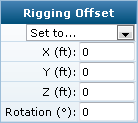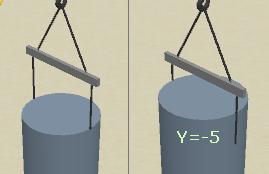Tutorial: Rigging Offset and Rotation
Introduction

By default, the load is centered directly below the hook. If you want to offset the load, you will need to modify the Rigging Offset
values on the Rigging Properties page.
Rigging Offset
The easiest way to offset the load is to choose a point from the "Set to" drop down box, such as "Top Right", "Top Back", or "Bottom Center".
This will automatically position the load so the hook is directly above the point you choose. If you select a "Top" point, the pick
points will be level with the top of the load. If you select a "Bottom" point, the pick points will be level with the bottom of the
load.

To offset the load to a different point, you will need to modify the X, Y, and Z values in the Rigging Offset box. To move the rigging forward
or backward, modify the X value. A positive X value will move the hook forward. A negative X value will move the hook backward.

To move the pick points down to the side or bottom of the load, modify the Rigging Offset Y value.
If you change the load angle or rotation (on the Load Details page), the coordinate axes also rotate. For instance, if you rotate the load
90 degrees, changing the Rigging Offset X value will now move the load left and right instead of forward and back. If you change the Load
Angle to 90 degrees, the X-axis will be oriented vertically, so adjusting the Rigging Offset X value will move the pick points up and down.
Load Rotation vs Rigging Rotation
When you change the Load Rotation the rigging also rotates with the load. To rotate the rigging objects without rotating the load,
you should change the Rotation value on the Rigging Details page.
Load Rotation

Rigging Rotation
